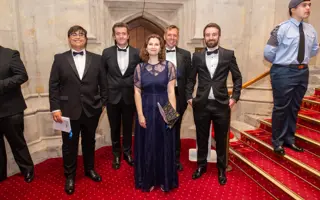
Why dyslexia and structural engineering fit together
From Stonehenge to the Shard, structures make iconic marks on skylines. Among the many things they do, they help people get from place to place, from the Tyne Bridge to the Elizabeth line. And of course, like the roof over your head – they provide shelter.
For all these examples and more, structures engineered by people require careful planning and consideration. Most buildings are designed to withstand at least 50 years (and bridges, 100 years) – although in all likelihood, they’ll last even longer. So, structural engineers have a visible, long-lasting impact on society for generations to come.

© Unsplash / Simone Hutsch
The skills for an iconic career
Structural engineers ensure buildings and structures are stable against loads from people and weather (increasingly, with climate change). In certain regions, they must account for natural hazards such as earthquakes, hurricanes and sinkholes.
And it’s not just about new structures. Structural engineers are increasingly concerned with transforming or renovating existing buildings, to save on embodied carbon while meeting design needs.
Structural engineering is a highly collaborative discipline. You might be found sketching in the design office or using FEM (finite element modelling) software. But much of the job involves discussion with colleagues and contractors in meetings and via email. You’ll also visit sites and produce reports.
Structural engineers are normally trained to a high level in maths, physics, and computational analysis – but must also be excellent communicators and creative thinkers.
These aren’t the only drivers of success, though. The discipline is a challenging area that needs students with an aptitude to learn and a desire to problem solve for the better.

© Unsplash / Simone Hutsch
Structural engineering with dyslexia
Every student should hold onto their ambition and passion for their subject until the very end of their career. However, specific learning differences (SpLD) such as dyslexia may challenge many considering structural engineering as a career.
It may come as a surprise to learn that, as a student that has lived with this difference, I’ve found the challenges presented by my dyslexia can largely be contained under certain circumstances.
The best tutor I ever had (and still have) once said, if you believe you can do a task and embody that belief, you’ll achieve it. I try to always apply this to stay optimistic, and never allow pessimism to overtake.
I try to sign up to virtually any opportunity that comes my way, to allow my eagerness and passion to come into play. For example, this might be engaging in IStructE (Institute of Structural Engineering) events, blogging, or being a QEPrize (Queen Elizabeth Prize for Engineering) Ambassador. To make interview prep easier, I keep a diary of my achievements, regularly update my CV and collate cover letters I write.
But the most important way to differentiate yourself is work experience – whether a year-long placement or a paid, summer or voluntary internship. A first-class degree is an advantage, but real-world experience can set your application apart.

© Unsplash / Simone Hutsch
Creativity and problem-solving
Dyslexia can limit motor coordination, organisation, focus, mental arithmetic, and language-processing skills. However, these are not the only markers of the learning difference.
A 2018 study, The Value of Dyslexia, showed that individuals with dyslexia often have an exceptionally high complex problem-solving ability. Indeed, scientists such as Stephen Hawking and Leonardo da Vinci were thought to have symptoms of dyslexia.
The report also showed they demonstrate strong critical thinking, people management and creativity skills – all essential for structural engineers.
While retaining and processing information can be a challenge, students with dyslexia are often able to ‘think outside the box’. Seeing problems from different angles allows them to organise seemingly disparate pieces of information into a narrative that makes sense.
This translates into dyslexic students excelling in design problems.
As the world evolves – with increasing demands from climate change and a growing global population – the need for more innovative designs becomes increasingly evident.
Neurodiverse thinkers, such dyslexic people, are needed to innovate and enable a more sustainable future. These thinkers will ensure that structural engineering serves humankind and the planet.
Contributors
Omar Shobair is a postgraduate student studying structural engineering at UCL. He has a keen interest in the structural behaviour of high-strength steel members and connections and how they can be used in more sustainable structures, both on- and offshore. Omar aims to contribute to this area of engineering by furthering design quality to conform to current sustainability provisions set by Eurocode and British Standards.
Get a free monthly dose of engineering innovation in your inbox
SubscribeRelated content
Civil & structural

Building the Shard
The Shard is one of London's most iconic buildings. The tallest in Western Europe, it was designed by Italian architect Renzo Piano and dominates the city’s skyline. Ingenia spoke to John Parker, project director for structural engineers WSP, who outlined the engineering decisions made in building the enormous steel and glass structure.

The return of arched bridges
Arch bridges are strong, durable and require little maintenance. However, very few had been built since the early 1900s until the FlexiArch was developed and launched in 2007. Now, there has been a minor renaissance for this ancient form of construction.

Creating user-friendly buildings
For Michelle McDowell, a former Business Woman of the Year, a passion for joined-up design thinking and building information modelling with a user-friendly approach has enabled her to pioneer revolutionary changes in her field.

Troja Bridge
In November 2014, one of the world’s largest network arch bridges was officially opened in Prague. The UK may soon have its first network arch bridge if the go-ahead is given for a new rail project in Manchester.
Other content from Ingenia
Quick read

- Environment & sustainability
- Opinion
A young engineer’s perspective on the good, the bad and the ugly of COP27

- Environment & sustainability
- Issue 95
How do we pay for net zero technologies?
Quick read

- Transport
- Mechanical
- How I got here
Electrifying trains and STEMAZING outreach

- Civil & structural
- Environment & sustainability
- Issue 95